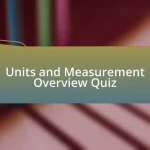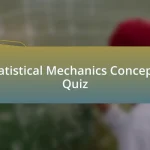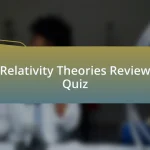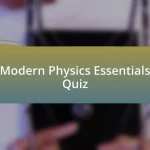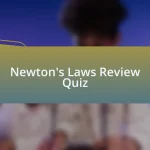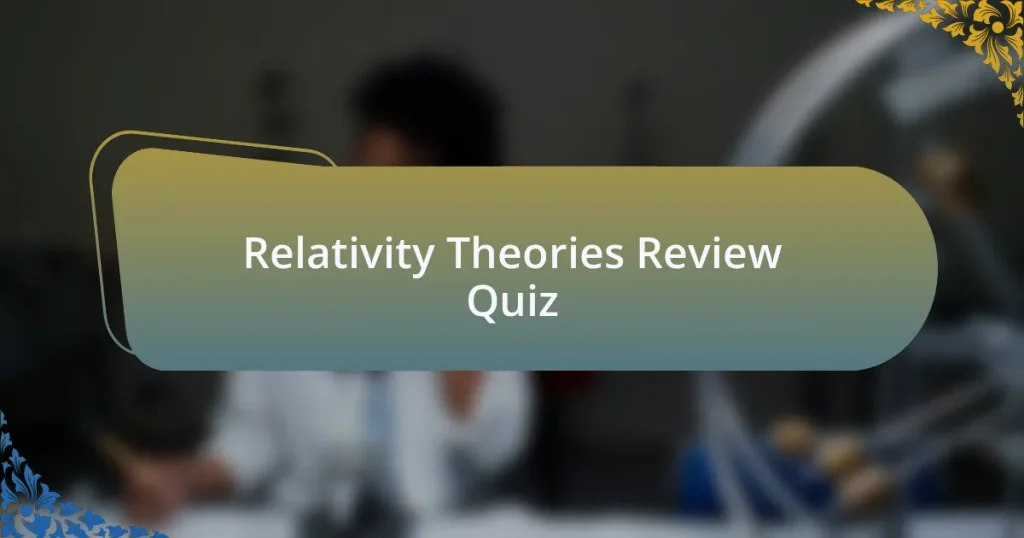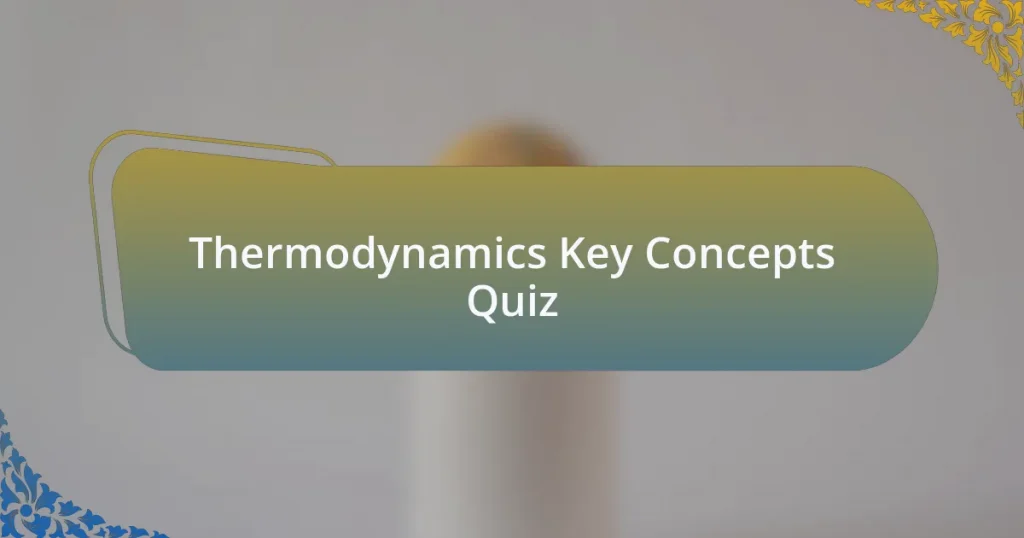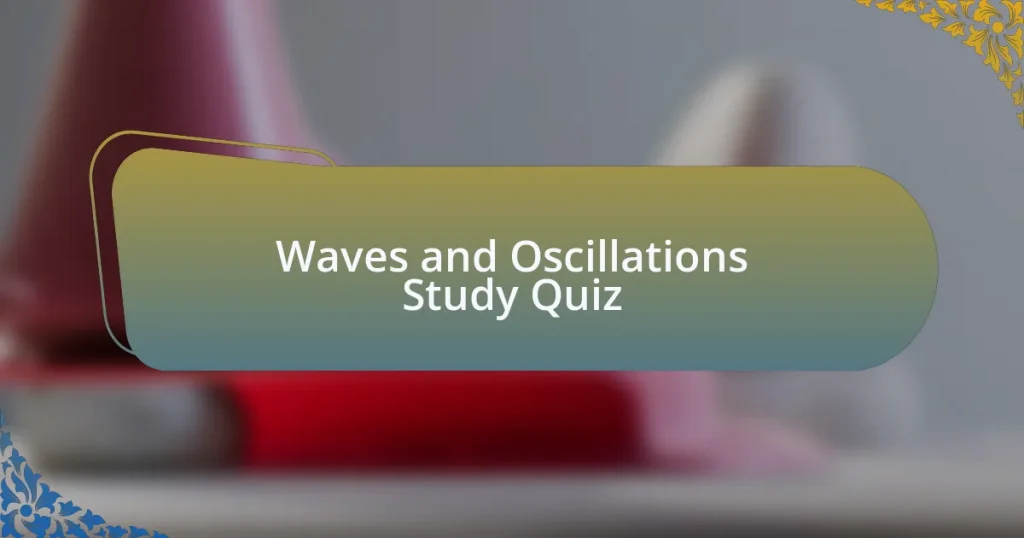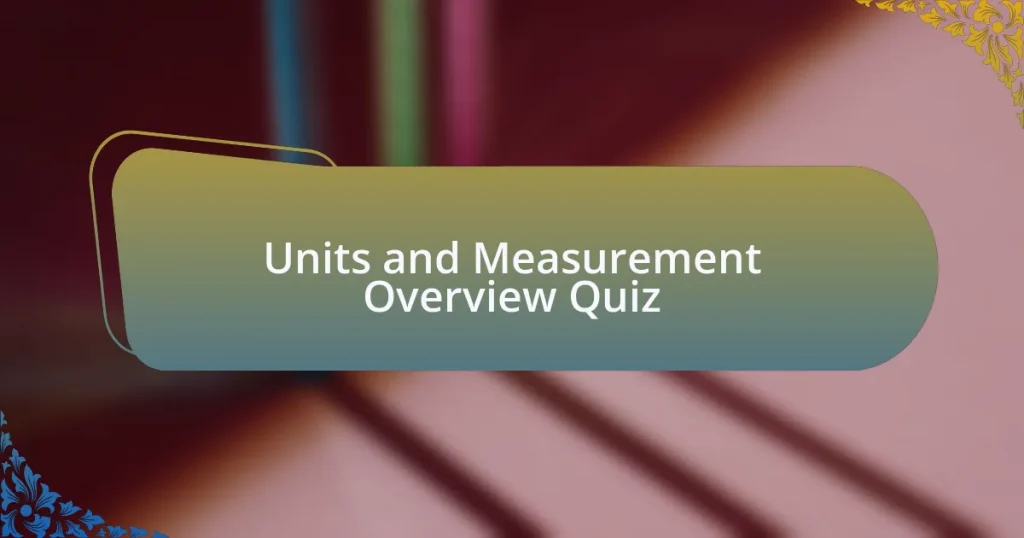Start of Relativity Theories Review Quiz
1. Which theorem defines the structure of space-time?
- Quantum mechanics principle
- Electromagnetic theory
- Newton`s law of motion
- Special relativity theory
2. State true or false: Light rays will bend in the gravitational field.
- Only in a vacuum
- FALSE
- TRUE, but only sometimes
- TRUE
3. Name the fundamental forces in the universe.
- Magnetism, electricity, buoyancy, and surface tension.
- Gravity, inertia, friction, and tension.
- Gravity, electromagnetism, the weak force, and the strong force.
- Sound, magnetic force, nuclear force, and thermal energy.
4. What is the speed of light in miles?
- 300,000 miles/sec
- 75,000 miles/sec
- 150,000 miles/sec
- 186,000 miles/sec
5. Which theory gives the relationship between space and time?
- Classical mechanics theory
- Special relativity theory
- String theory
- Quantum mechanics theory
6. Theory of Relativity features which theories?
- Classical mechanics and quantum mechanics.
- Thermal dynamics and fluid dynamics.
- Special relativity theory and general relativity theory.
- Electromagnetism and wave theory.
7. Who developed the special theory of relativity?
- Niels Bohr
- Albert Einstein
- Isaac Newton
- Galileo Galilei
8. State true or false: The speed of light varies with respect to the person who measures and how fast the person measures it.
- VARIABLE
- TRUE
- FALSE
- DEPENDS
9. Which law is put forth by Albert Einstein?
- Law of motion
- Law of thermodynamics
- Law of relativity
- Law of gravitation
10. Mass–energy equivalence is given by the formula _____.
- p=mv
- F=ma
- E=mc²
- a²+b²=c²
11. Explain the relativity theorem.
- The relativity theorem states that light travels at different speeds depending on the observer`s velocity.
- The relativity theorem argues that objects in motion do not affect the perception of time.
- The relativity theorem states that space and time are relative, and all motion must be relative to a frame of reference.
- The relativity theorem claims that space is fixed and time flows independently of motion.
12. State the special theory of relativity.
- The special theory of relativity claims that mass can be created from energy without limits.
- The special theory of relativity deals with the laws of physics in non-accelerating frames of reference and introduces the famous equation E=mc².
- The special theory of relativity suggests that time and space are absolute and unchanging.
- The special theory of relativity states that light can travel faster than the speed of sound.
13. State the general theory of relativity.
- The general theory of relativity explains gravity as the curvature of spacetime caused by the presence of massive objects.
- The general theory of relativity states that gravity is a force that acts at a distance.
- The general theory of relativity claims gravity can be ignored in empty space.
- The general theory of relativity describes gravity as a property of mass itself.
14. Explain the concept of length shrinking.
- Length stops existing entirely when an object approaches the speed of light.
- Length increases as an object approaches the speed of light due to mass gain.
- Length appears to shrink when an object moves at relativistic speeds due to time dilation and length contraction.
- Length can be measured without any changes regardless of speed.
15. What is mass-energy equivalence?
- E=mc²
- E=mv²
- E=m²c
- E=m/c²
16. What is the twin paradox?
- The twin paradox is a theory that states that both twins age at the same rate, regardless of their speed.
- The twin paradox is a thought experiment where one twin travels at high speed relative to the other twin, resulting in time dilation and a difference in their ages upon return.
- The twin paradox is a phenomenon where both twins experience the same amount of time passing during their journey.
- The twin paradox is a problem in physics that suggests time cannot be measured accurately by moving observers.
17. How does the speed of light remain constant?
- The speed of light varies with the gravitational field strength affecting it.
- The speed of light remains constant irrespective of who measures it or how fast the person measuring it is moving.
- The speed of light can change based on the medium it travels through.
- The speed of light is constant only in a vacuum, not in other environments.
18. What is the principle of equivalence?
- The principle of equivalence states that objects in a vacuum will fall slower than those in air.
- The principle of equivalence states that all objects fall at the same rate in a gravitational field, and that gravity is equivalent to acceleration.
- The principle of equivalence states that gravity only affects larger objects differently than smaller ones.
- The principle of equivalence states that all objects have the same weight regardless of their mass.
19. What is gravitational lensing?
- Gravitational lensing is the bending of light around massive objects due to the curvature of spacetime.
- Gravitational lensing is the dispersion of light through clouds of gas and dust in space.
- Gravitational lensing is the reflection of light from surfaces in space creating images.
- Gravitational lensing is the process of light being absorbed by black holes, disappearing entirely.
20. What are gravitational waves?
- Gravitational waves are particles that carry gravitational force through space.
- Gravitational waves are fluctuations in magnetic fields caused by stellar explosions.
- Gravitational waves are sound waves created by moving objects in the universe.
- Gravitational waves are ripples in spacetime produced by the acceleration of massive objects.
21. What is a black hole?
- A black hole is a massive star that rapidly spins.
- A black hole is a void in space that absorbs surrounding matter.
- A black hole is a theoretical object that emits light.
- A black hole is a region of spacetime where gravity is so strong that nothing, not even light, can escape.
22. How does general relativity predict phenomena like gravitational waves and black holes?
- General relativity describes forces acting at a distance without needing mass.
- General relativity suggests that mass has no influence on spacetime structure.
- General relativity states that gravity doesn’t affect time or light.
- General relativity predicts phenomena like gravitational waves and black holes by describing the curvature of spacetime caused by massive objects.
23. What is the Lorentz transformation?
- The Lorentz transformation is a mathematical formula that describes how space and time coordinates are transformed from one inertial frame to another.
- The Lorentz transformation is a technique used for measuring acceleration in classical mechanics.
- The Lorentz transformation is a method for calculating gravitational forces between masses.
- The Lorentz transformation is a principle that applies only to objects at rest.
24. How does time dilation occur?
- Time dilation occurs only near black holes, where time stops completely.
- Time dilation occurs when an object travels faster than the speed of light, resulting in negative time.
- Time dilation is an effect that happens only in a vacuum with no external forces acting on it.
- Time dilation occurs when an object moves at relativistic speeds, causing time to pass slower for the moving object relative to a stationary observer.
25. What is the relativistic mass?
- The relativistic mass is the original mass of an object multiplied by the speed of light.
- The relativistic mass is the mass of an object as measured in a moving frame of reference, which increases with velocity.
- The relativistic mass is the constant mass of an object in any frame of reference.
- The relativistic mass is equal to gravitational mass only when at rest.
26. How is the length of an object measured at relativistic speeds?
- The length of an object appears shorter when measured at relativistic speeds due to length contraction.
- The length of an object increases when measured at relativistic speeds.
- The length of an object remains the same regardless of its speed.
- The length of an object is irrelevant when moving at high speeds.
27. What is the equation for relativistic momentum?
- p = mv²
- p = 2mv
- p = mgh
- p = γmv
28. How does the Lorentz factor (γ) relate to velocity?
- The Lorentz factor (γ) is given by γ = 1 / sqrt(1 – v^2/c^2), where v is the velocity and c is the speed of light.
- The Lorentz factor (γ) is unrelated to speed and only pertains to mass.
- The Lorentz factor (γ) is constant and does not depend on velocity.
- The Lorentz factor (γ) decreases as velocity increases.
29. What happens to an object`s kinetic energy as it approaches the speed of light?
- An object`s kinetic energy remains constant as it approaches the speed of light.
- An object`s kinetic energy decreases as it approaches the speed of light.
- An object`s kinetic energy is halved as it approaches the speed of light.
- An object`s kinetic energy approaches infinity as it approaches the speed of light.
30. How does general relativity explain the curvature of spacetime?
- General relativity states that spacetime is always flat regardless of mass.
- General relativity claims that time moves faster near massive objects.
- General relativity suggests that light does not interact with the curvature of spacetime.
- General relativity explains the curvature of spacetime by describing how massive objects warp spacetime around them.
Quiz Successfully Completed!
Congratulations on completing the quiz on Relativity Theories Review! This exercise was more than just a series of questions; it was an opportunity to deepen your understanding of two pivotal theories in physics: Special Relativity and General Relativity. Through this quiz, you may have reinforced your grasp of fundamental concepts such as time dilation and the curvature of spacetime, which are essential in comprehending the universe’s structure.
Engaging with this material not only tests your knowledge but also encourages critical thinking about how these theories explain the behavior of objects in motion and the influence of gravity. Each question prompted you to reflect on the implications of relativity in both theoretical frameworks and real-world scenarios. It is clear that a strong foundation in these concepts is essential for anyone serious about pursuing physics further.
We invite you to continue your learning journey by exploring the next section on this page dedicated to Relativity Theories Review. This resource will provide you with an in-depth analysis, illustrations, and additional examples to help fortify your understanding. Expanding your knowledge in this area will not only aid in your test preparation but also inspire a greater appreciation for the complexities of the universe. Happy learning!
Relativity Theories Review
Overview of Relativity Theories in Physics
Relativity theories consist of two major frameworks proposed by Albert Einstein: Special Relativity and General Relativity. Special Relativity addresses the physics of objects moving at constant speeds, particularly at speeds close to the speed of light. It revolutionizes our understanding of space and time, positing that they are interwoven into a single continuum called spacetime. General Relativity, on the other hand, extends this concept to include gravity, describing it not as a force but as the curvature of spacetime caused by mass. Both theories have profound implications in physics and help explain various phenomena, from the behavior of atomic particles to the dynamics of galaxies.
Key Concepts of Special Relativity
Special Relativity introduces several fundamental concepts, including the constancy of the speed of light and time dilation. The theory states that the speed of light in a vacuum is constant and is the maximum speed at which information can travel. Time dilation occurs when an object moves at high speeds, causing time to pass more slowly for it compared to a stationary observer. Another significant concept is length contraction, where an object in motion appears shorter in the direction of movement to a stationary observer. These concepts reframed classical mechanics, showing that time and space are not absolute but relative to the observer’s state of motion.
Applications of General Relativity
General Relativity has several practical applications across various fields. It is essential in understanding gravitational phenomena, such as the bending of light around massive objects, known as gravitational lensing. The theory also plays a critical role in astrophysics, explaining the dynamics of black holes and the expansion of the universe. Moreover, GPS technology relies on adjustments made for time dilation effects predicted by General Relativity, ensuring accurate positioning data. These applications demonstrate the theory’s far-reaching impact on both theoretical physics and everyday technology.
Experimental Evidence for Relativity Theories
Multiple experiments have validated the predictions of both Special and General Relativity. One prominent example is the Hafele-Keating experiment, where atomic clocks flew on commercial flights, showing significant time dilation effects consistent with Special Relativity. Additionally, observations of the perihelion shift of Mercury’s orbit confirmed predictions made by General Relativity, illustrating how the curvature of spacetime influences planetary motion. These experimental results solidify the theories’ standing in the scientific community, providing robust support for their principles.
Comparative Analysis of Relativity and Newtonian Physics
Relativity theories fundamentally differ from Newtonian physics, especially in how they treat time and space. Newtonian physics is based on absolute time and space, assuming uniformity in these dimensions. In contrast, relativity emphasizes their interdependence, showing that measurements of time and space can vary between observers in motion relative to one another. This shift has significant implications, particularly at high velocities and strong gravitational fields, where Newtonian predictions fail. The comprehensiveness of relativity in addressing these scenarios marks its superiority over classical mechanics.
What are the key principles of Einstein’s theory of relativity?
Einstein’s theory of relativity consists of two main parts: special relativity and general relativity. Special relativity, published in 1905, asserts that the laws of physics are identical for all observers in uniform motion, introducing the concept that the speed of light is constant and not dependent on the motion of the light source. General relativity, released in 1915, expands this idea to include gravity, describing it as a curvature of spacetime caused by mass. The main principles, including time dilation and length contraction, have been validated by numerous experiments, such as the observation of time differences in atomic clocks on fast-moving jets.
How does one prepare for a physics test on relativity theories?
To prepare for a physics test on relativity theories, students should study key concepts such as time dilation, length contraction, and the equivalence principle. Practicing problems involving Lorentz transformations is essential. Utilizing resources like textbooks and online simulations can help visualize complex concepts. Engaging in group study sessions to discuss these theories and solve practice questions enhances understanding. Past exam papers focusing on relativity can provide a realistic preparation experience. Regular review of these materials reinforces knowledge and problem-solving skills necessary for the test.
Where can I find reliable resources on relativity theories for test preparation?
Reliable resources on relativity theories can be found in academic textbooks such as “Spacetime Physics” by Edwin F. Taylor and John Archibald Wheeler. Online platforms like Khan Academy and MIT OpenCourseWare offer free courses and video lectures. University libraries often have access to scholarly articles and research papers on relativity. Additionally, physics forums and educational websites provide interactive materials to aid in understanding. These resources ensure a comprehensive grasp of relativity theories for effective test preparation.
When was the theory of relativity first proposed and accepted?
The theory of relativity was first proposed in 1905 with Albert Einstein’s publication of the special theory of relativity. The general theory of relativity followed in 1915. Acceptance grew significantly after experimental evidence supported its predictions, such as the bending of light around massive objects observed during the solar eclipse of 1919. This confirmation by notable figures such as Sir Arthur Eddington helped establish general relativity as a fundamental theory in physics.
Who is credited with developing the theories of relativity?
Albert Einstein is credited with developing the theories of relativity. His work fundamentally changed our understanding of space, time, and gravity. The special theory of relativity introduced in 1905 and the general theory of relativity introduced in 1915 are foundational contributions to modern physics. Einstein’s insights have since been supported by extensive experimental evidence and continue to influence scientific research.


